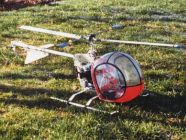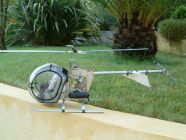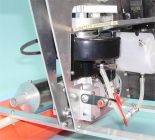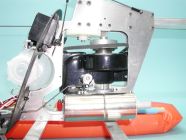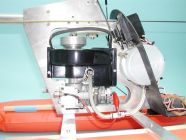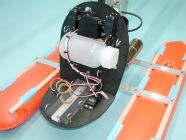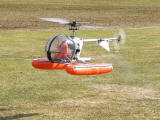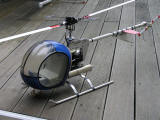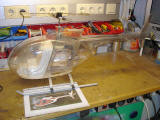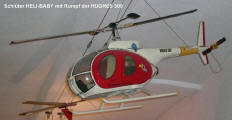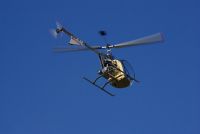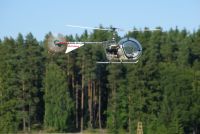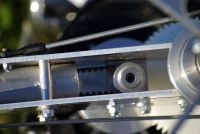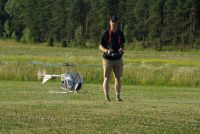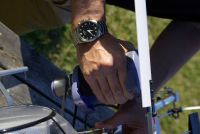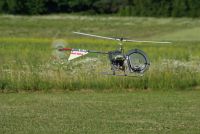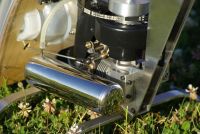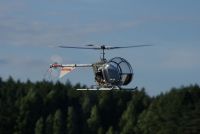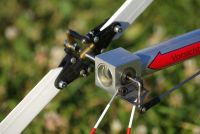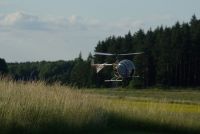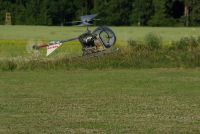Schlüter Heli-Baby (1975)
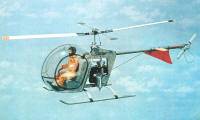 |
Specification:
|
||||||||||||||||||
| Documents: | |||||||||||||||||||
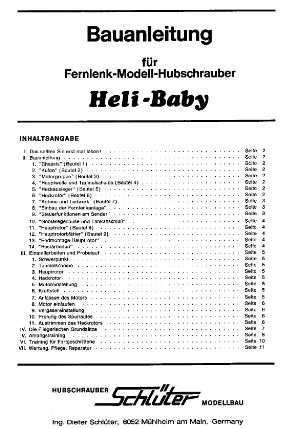 Heli-Baby assembly manual -(German) |
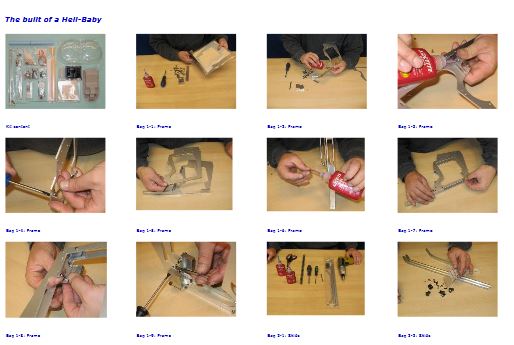 Heli-baby build guide Heli-baby build guide Pictorial version. |
_small.JPG) |
|||||||||||||||||
|
|
 Super Heli-Baby assembly manual - German |
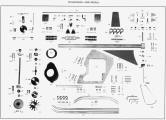 Parts view |
|||||||||||||||||
| Reports: | |||||||||||||||||||
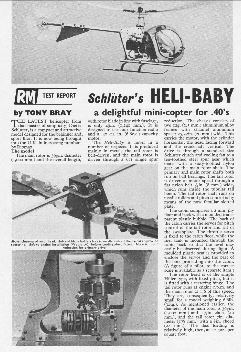 Oct 75 Heli-Baby review by Tony Bray RCM&E |
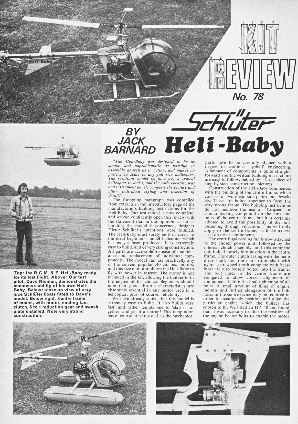 Nov 75 Heli-Baby review Radio Modeller |
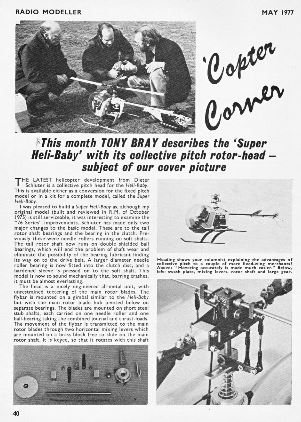 Super Heli-Baby review - Magazine review concerning the collective pitch head from May 77 Radio Modeller. |
|||||||||||||||||
The first Schlüter helicopters were scale models because it was considered that if you were going to fly one then it should actually look like a real one however, these were seriously expensive and so only a limited number of people could afford to 'take the plunge'. They were also difficult to repair as any 'crash' would damage the body and thus require a time consuming repair to be carried out. In addition the manufacturing process was limited to how quick the fuselages could be made which meant there was always a long waiting list to supply the models. What was needed was something much simply that could be repaired easily and quickly with manufacturing production not dependent upon any one time consuming to make item.
Having seen a number own designs examples with this 'minimalistic' approach he decide to pursue this direction. The concept was very similar to the UK MM Lark but instead of a single side frame, for greater rigidity the drive components were 'sandwiched' between two much thinner side frames which in fact was to prove the basic layout for all future pod and boom helicopters. Though a collective pitch system had been developed it was considered that the much easier fixed pitch system both for setting up and flying characteristics was more appropriate' it was also the cheapest option and pricing was a major consideration for increasing helicopter sales. The original design layout did not appeal to Dieter at the size required for the 'common' sixty engine because the long tail boom looked completely out of place and just 'wrong' when compared to its scale brethren. The model was therefore sized down to suit the popular '40' size engines and whilst the body size did not get significantly smaller the length of the tail boom reduced dramatically resulting in a more aesthetically pleasing look. Though it was not originally designed to look like a real helicopter a 'bubble' canopy gave it a resemblance to the Bell 47, which at that time was one of the most well know 'full size' helicopters. Accepting this and giving it basic 'cabin' layout provided the best of both worlds of a 'pod and boom' with a scale look. Whilst it could have been marketed as a Bell 47, the prototype had actually named itself by being known as "the little baby that looks really cute" (loose translation of the German original); thus the Heli-Baby was born.
Unfortunately problems caused by Schuco-Hegi pulling out of the partnership in 1973 meant that focus had to be maintained on the models already under production whilst Schlüter's new company was formed resulting in the release of the Heli-Baby being delayed until 1975. This decision did not harm sales and in fact it ensured that production capacity could meet the demand which is just as well as it proved to be very popular.
The flying characteristics were relatively benign due in some respects to the fact that it was quite heavy for its engine size so it was not 'overpowered' however, with it being small it was prone to spinning round when flown in calm conditions. It has to be remember that Kavan had only recently introduced a gyro for tail rotor control and they were very expensive (more than the engine....) so it was generally flown without anything to dampen the tail swing when power was changed. Too much power and it would be like have a 'tiger by the tail' with the resultant loss of orientation and if panic set in; followed by the crash. To aid the learning process a float set was an option and with these fitted the helicopter could 'slide around' on the ground whilst the pilot got used to the way the controls worked. This was an excellent way to begin and I remember that my first helicopter was a Heli-Baby with floats and I only damaged one pair of blades in learning to hover; I also remember numerous times when it swung round 180 degrees and 'came at me' having to step 'smartish' out of the way; wait for it to go past, then once in the normal behind the helicopter control position, slow it down and land.
However, and there nearly always is an 'however' for a totally new concept; the tail rotor drive was by pulley and round belt but when it got warm it would slip, especially if belt tension was not properly checked. Tail drive would be affected and the model would have to be landed quickly in order not to lose all directional control. 500 kits had already been despatched when this was found out so it was necessary to redesign for a flat belt which kept its tension better and to send out modification kits to all registered owners.
The Heli-Baby had a 'vee' machined in the flywheel positioned between the fan and the clutch housing with the recommended starting procedure to use a round belt pulled tight in this 'vee' and then 'whipped' back. Worked most of the time but it was difficult to steady the belt and pull through whilst holding the head; unfortunately every so often the belt would slip and catch on the fan casing ripping it off; guess how I know that...!!!
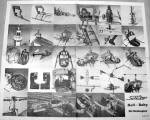



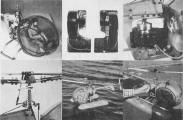
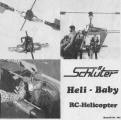
Constructional photo's for the Heli-Baby manual.
Fixed pitch 'teeter' head without damping and a simplified version of the original 1972 fixed pitch head with ball bearings fitted to the cyclic movement but brass bushes only for the teeter bearings. With fixed coning angle and no lead-lag or flap facility.
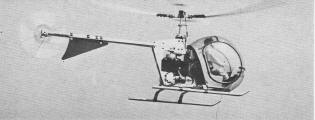
 Nov 75 Heli-Baby review by Jack Barnard from UK magazine Radio Modeller
Nov 75 Heli-Baby review by Jack Barnard from UK magazine Radio Modeller
Comments of the day were very favourable concerning a relatively easy build and set-up. The testers did confirm that the model was a little sensitive in rotation due to its small size but that fitting the floats was a very good trainer aid and actually stabilised the helicopter even more.
build hints by Dave Nieman from Aug 76 RCM&E. Interesting to note that Dave after a year of using the Heli-Baby comments that the cyclic controls were too slow; perhaps even too slow for learners? Though my model was a fixed pitch Heli-Baby II (no real different to this first version) I think I would have to agree with that statement as I found it needed large movements of the transmitter sticks to have any real effect on hover performance because, (as I now know but didn't then) it had a very slow 'follow up' rate due to heavy paddles. Memory plays tricks in trying to remember back 30 years but I never did get the Heli-Baby to do anything other than hovering or slow ;walking' speed flight and in any turbulence it was difficult to keep it still. I cannot even remember now what happened to it though I know I bought another helicopter with collective pitch instead so that I had better control; wonder where it did go?
 Catalogue picture 1976.
Catalogue picture 1976. 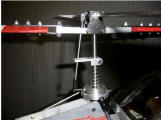
Uprated version of the Heli-Baby 1975 head incorporating lead-lag and the 'flat' fitting of the blade holders in order to help retain the pitch setting if the blades are removed.
Schlüter Super Heli-Baby (1976)

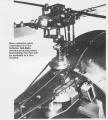
Collective control by a rod running in a sleeve up the main mast and moving the mixer block position above the flybar linkage driver. Linkages connected this block to both the main blades and flybar thus collective control was 'superimposed' on the flybar cyclic movement (Hiller only). No lead-lag or flapping facility but had slight teeter movement restrained by sleeves. The layout though lacked engineering 'finesse' as it was basically an 'add on' but it did have rotational balance.
 Catalogue
Catalogue 

 Construction views
Construction views _small.jpg)
![]() 1976 adverts US & UK
1976 adverts US & UK 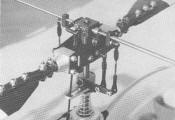
 Head close-up's.
Head close-up's.
The popularity of the Heli-Baby was such that only a year after its introduction, the collective pitch version was produced along with a conversion kit to upgrade the fixed pitch model. Helicopter radios had not even been considered at this point so it was necessary to provide a 'mechanical' form of mixing between the main and tail rotor pitch settings in order to 'emulate' the balance that a fixed pitch system had by default. As can be seen from the head photo below, collective control was by a rod running in a sleeve up the main mast and moving a slider which incorporated mixing arms that were connected to both the flybar and each blade; thus collective control was 'superimposed' on the flybar cyclic movement (Hiller only). Cyclic control was therefore near enough the same as the fixed pitch Heli-baby but with the added ability of better circuit flying and no loss of revs when making an approach. The layout though lacked engineering 'finesse' as it was basically an 'add on' but it did have rotational balance.
Super Heli-Baby review - Magazine review concerning the collective pitch head from May 77 Radio Modeller. Mainly a build and set up review with the only comment being that cyclic and tail response was the same but now height control in the circuit much improved which is exactly what you would have expected.
Schlüter Heli-Baby Hughes 500 (1977)
With the introduction of the Bell_222 which used a Pod and Boom body with a 'Hang on' fuselage, it was decide to use this formulae of a 'full' body for the Heli-Baby as well. However, as the Heli-Baby was quite a 'dumpy' machine a suitable and similar looking full size machine would be needed and the Hughes 500D fitted the requirement perfectly.
Schlüter Heli-Baby II (1979)
 Catalogue picture 1979
Catalogue picture 1979  Catalogue picture 1976.
Catalogue picture 1976.
In 1979 the model was revised and called the Heli-Baby II / Super-Baby II. Not sure though of the changes to the fixed pitch models as the catalogue still used the same picture as that from 1976 (as noted above). The collective pitch version differed in the head layout as it now incorporated the head from the original Bell_222giving a much tidier layout though still only retaining basic Hiller control.
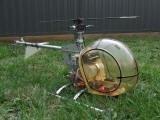

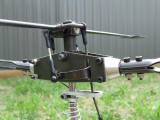 Bell_222 head fitted to the Heli-Baby II.
Bell_222 head fitted to the Heli-Baby II.
By 1980 the replacement for the Heli-Baby, the Mini-Boy, was under development and sales were dropping; probably in no small part due to the fact that it was expensive when compared to others 'learner' machines and also for just a more money, the Heli-Boy could be bought. Schlüter sold the license (and tooling) to Garbo of Italy who without the overheads of development and new tooling could provide the machine at a much cheaper price and thus the Zenith came into being.
Schlüter New Heli-Baby (2007)
In 2007 a replica of the original Heli-Baby (with support from Mr Schlüter himself) was produced by Mr. Guzicki from minicopter and although relatively expensive for what it was there was enough pre-orders ' on the books' to make it viable for a limited run; as an aside I had one of these bought for my birthday present as the Heli-Baby (as noted above) had been my first ever RC helicopter.
Checkout this site for the replica Heli-Baby. http://www.helibaby.de/en/index.htm
New Heli-Baby build and flight
Action Man New Heli-Baby build montage
I believe that builder Rob has passed on his new Heli-Baby however, for posterity here is his extremely well produced stills montage of Action Man building a new Heli-Baby with help (or is that hindrance) from Barbie.
Action man Heli-Baby build - PDF file as I don't have a screen show active on the site

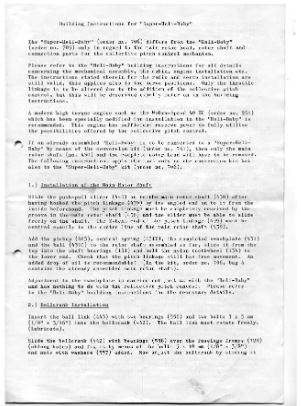





_small.jpg)
_small.jpg)
